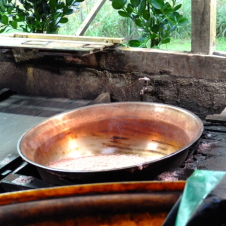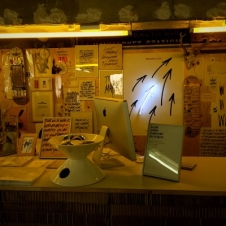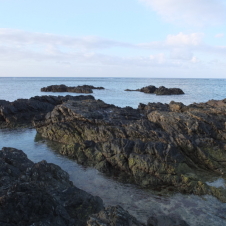DAYS_
Mud-dye workshop
January 09, 2015 / DIARY, INFO
At Citruss, Fukuoka Parco 5th floor, is now open “New Year Island – Amami Oshima tomo no kai”.
I went to the “mud-dye workshop” by Kanai kobo, one of the events.
At the end of the last year, I was in Amami Island for an article about mud-dye, but I cannot try it myself because I had to take pictures and do interviews. So, this time, also in order to understand better the dyeing process in a journalistic sense, I tried dyeing myself.
A simple explanation of the mud-dye used in Amami Island.
First, the textile goods are dyed in a solution made with boiled sharinbai (the red one in the picture below), a plant that grows in Amami Island. Then, they are dyed in a mud (the black one in the picture below) rich of iron, present in the layer of soil since 1500000 years ago. The color changes for the chemical reaction between the solution of sharinbai and the mud.
In this workshop, the mud is used to get a final grey tone color, for the pink color, the mud is not used.
First, red dyeing solution, then mud dyeing solution: repeating this process, the final color tends to become black.
Following, the steps of the process:
 My eldest daughter finished the school early today because of the new term, and she will be my assistant.
My eldest daughter finished the school early today because of the new term, and she will be my assistant.
 First, Mr. Kanai (left) explains the mud-dye process.
First, Mr. Kanai (left) explains the mud-dye process.
 For some patterns, the fabric is tied with thread.
For some patterns, the fabric is tied with thread.
 I’m going to color the handkerchief in pink, and the T-shirt in grey.
I’m going to color the handkerchief in pink, and the T-shirt in grey.
 For getting the grey tone, 2 times in the red solution, then mud, then rinse in water, and repeat.
For getting the grey tone, 2 times in the red solution, then mud, then rinse in water, and repeat.
 For getting the red tone, 2 times in the red solution, then rinse, and repeat.
For getting the red tone, 2 times in the red solution, then rinse, and repeat.
Then the thread is removed…
 …and that’s the result.
…and that’s the result.
 Because of the lighting and because it’s wet, it looks dark, but the actual color of the T-shirt is a light grey.
Because of the lighting and because it’s wet, it looks dark, but the actual color of the T-shirt is a light grey.
The workshop will go on until tomorrow. Because the number of participant is limited, check it out at Citruss in advance.






COMMENTS_